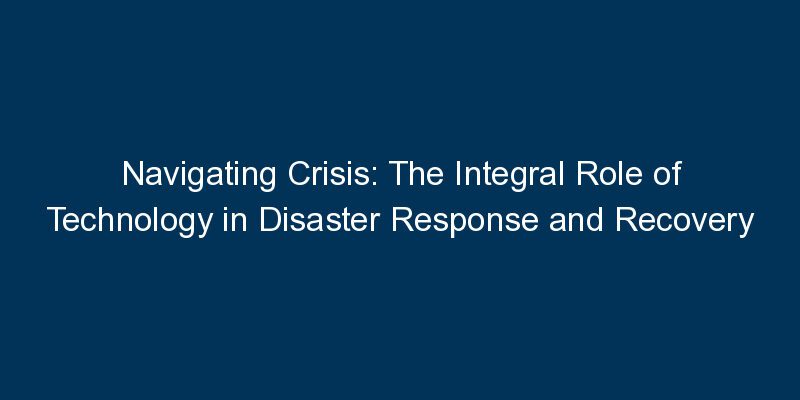In the face of natural disasters and emergencies, technology emerges as a beacon of hope and resilience, playing a pivotal role in disaster response and recovery efforts. This blog sheds light on the critical functions of technology in times of crisis, exploring how innovations in communication, data analytics, and artificial intelligence contribute to efficient disaster management.
I. Early Warning Systems: Proactive Disaster Preparedness
Early Detection and Alerts
One of the primary functions of technology in disaster response is the establishment of early warning systems. Advanced sensors, satellite imagery, and data analytics enable the timely detection of potential disasters such as hurricanes, earthquakes, and floods. These systems trigger automated alerts, providing crucial time for evacuation and preparedness.
Mobile Apps for Emergency Alerts
Mobile applications play a crucial role in disseminating real-time emergency alerts to individuals in affected areas. These apps provide information on evacuation routes, shelter locations, and safety guidelines, empowering people to make informed decisions during critical moments.
II. Communication Technologies: Ensuring Connectivity Amidst Chaos
Satellite Communication
Disasters often disrupt traditional communication infrastructures. Satellite communication technologies step in to bridge this gap, providing reliable and resilient connectivity for emergency responders, relief organizations, and affected communities. This ensures that critical information can be relayed even in areas with damaged or non-functional communication networks.
Social Media Platforms
The ubiquity of social media platforms has transformed the way information is shared during disasters. These platforms serve as vital communication channels for affected individuals to seek help, share updates, and connect with rescue organizations. Emergency services also utilize social media for real-time situational awareness and coordination.
III. Big Data and Analytics: Informed Decision-Making
Predictive Analytics for Resource Allocation
Big data analytics plays a crucial role in disaster response by providing insights into resource allocation. Predictive analytics models analyze vast datasets to anticipate the areas most affected and allocate resources such as medical supplies, food, and personnel accordingly.
Geospatial Mapping for Situational Awareness
Geospatial mapping technologies offer real-time visualization of disaster-affected areas. This enhances situational awareness for both responders and the affected population, enabling better coordination and targeted relief efforts. Drones equipped with mapping capabilities contribute to rapid and accurate assessment of the disaster’s impact.
IV. Artificial Intelligence: Enhancing Efficiency and Accuracy
AI for Damage Assessment
Artificial Intelligence (AI) is employed for rapid damage assessment in disaster-stricken areas. Machine learning algorithms analyze aerial imagery to assess the extent of destruction, allowing for prioritized response efforts based on the severity of the damage.
Chatbots for Information Dissemination
During disasters, the demand for accurate and timely information is high. Chatbots powered by AI provide instant responses to common queries, freeing up human resources for more complex tasks. These virtual assistants are deployed on websites, apps, and social media platforms to disseminate critical information.
V. Remote Sensing Technologies: Monitoring and Evaluation
Remote Sensing for Environmental Monitoring
Satellites equipped with remote sensing technologies play a crucial role in monitoring environmental changes during and after disasters. From assessing flood extents to tracking changes in vegetation cover, remote sensing aids in understanding the evolving dynamics of the disaster-affected areas.
Unmanned Aerial Vehicles (UAVs) for Rapid Assessment
Drones, or UAVs, offer a rapid and flexible means of assessing disaster impacts. Equipped with cameras and sensors, drones capture high-resolution images and collect data from hard-to-reach areas, supporting quick and accurate damage assessments.
Conclusion
In the face of adversity, technology emerges as a powerful ally, transforming disaster response and recovery efforts. From early warning systems that provide crucial seconds for evacuation to AI-powered analytics that optimize resource allocation, each technological innovation plays a distinct role in navigating the complexities of disaster management. As we continue to witness advancements in technology, the synergy between human resilience and technological capabilities becomes increasingly evident. The role of tech in disaster response and recovery is not just about mitigating the immediate impacts but also about building a more resilient future where innovation and compassion unite to address the challenges posed by nature’s forces.



















Comments